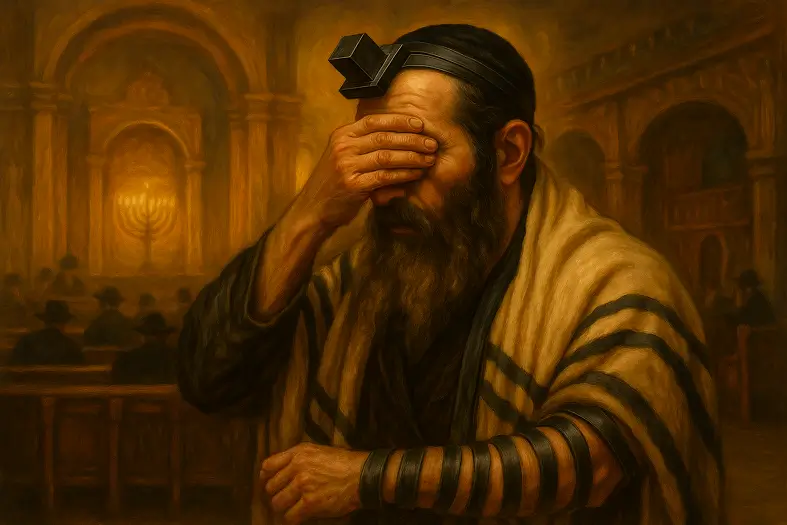


Every Jewish man is obligated to place fringes (tzitzit) on the four corners of his garments, including a thread of techelet when available, as a sign and reminder of all the mitzvot.
The mitzvah of tzitzit serves as a perpetual visual reminder to keep Hashem’s commandments. The Torah commands that every four-cornered garment worn must bear fringes, including a blue thread of techelet (wool dyed from the chilazon). The techelet thread was historically central, symbolizing both the sea and the heavens, leading one’s eyes and heart upward toward Hashem’s Throne of Glory (Menachot 43b). Rambam codifies tzitzit as a mitzvah dependent on wearing such garments, not an independent daily obligation; however, pious individuals ensure fulfillment by wearing a tallit katan. Sefer HaChinuch describes tzitzit as a tactile signpost binding Jews to constant mindfulness of mitzvot.
Commentary & Classical Explanation:
Contrast with Mitzvah 79 (To wear Tefillin on the head)
Parallel with Mitzvah 6 (To sanctify His Name)
The Torah (Numbers 15:38) commands not only that tzitzit be placed on the corners of garments, but that each set of fringes include a thread of tekhelet — a sky-blue wool. The Talmud (Menachot 43b) explains that tekhelet resembles the sea, which resembles the sky, which resembles the Throne of Glory — transforming a physical garment into a chain of reminders ascending toward Hashem’s majesty.
Halachically, the mitzvah has two independent components: white threads and a blue thread. When tekhelet is available, the mitzvah is fulfilled in full; when it is not, one still fulfills the mitzvah with white alone (Menachot 38a).
The Chilazon and Its Disappearance
The Torah specifies that tekhelet must come from a sea creature called the chilazon (Shabbat 26a). The dye was costly and rare; the Gemara (Menachot 44a) notes that its discovery was unpredictable, sometimes surfacing only rarely. By the Geonic period and certainly by the early Middle Ages, the chilazon’s identity was lost. The mitzvah of tekhelet effectively became dormant, with Jews wearing only white tzitzit.
Kabbalistic works (Zohar, Parashat Shelach 173a; writings of the Arizal) note that the absence of tekhelet reflects a diminished spiritual era — that the restoration of tekhelet would accompany the Messianic age.
Modern Rediscovery Efforts
From the 19th century onward, rabbis and scholars sought to re-identify the chilazon:
Divergent Halachic Approaches
Symbolism and Contemporary Reflection
Tekhelet is both a halachic thread and a symbolic one — binding sea, sky, and heaven; past, present, and future. Its reappearance in our day has reignited ancient debates, embodying the tension between tradition and discovery, and reminding every Jew who wears tzitzit — whether white or blue — that we stand daily before the Throne of Glory.
Public Jewish Identity
Mindfulness and Daily Alignment
Symbol of Eternity
Spiritual Resistance


Represents the concept of spiritual intentionality, purity, and sanctity—set apart for a higher purpose.
Represents Emunah—the deep, inner trust in Hashem’s presence, oneness, and constant involvement in our lives. This badge symbolizes a heartfelt connection to G-d, rooted in belief even when we cannot see. It is the emotional and spiritual core of many mitzvot.
Reflects mitzvot rooted in love—of G‑d, others, and the world we are entrusted to uplift.
Signifies awe and reverence toward Hashem—living with awareness of His greatness and presence.
Mitzvot that strengthen communal life — showing up, participating, supporting, and belonging. Community is where holiness is shared, prayers are multiplied, and responsibility becomes collective.
Tied to the eternal covenant between G‑d and the Jewish people, including signs like brit milah and Shabbat.
Mitzvot that define and deepen the relationship between a person and their Creator. These include commandments involving belief, prayer, Shabbat, festivals, sacrifices, and personal holiness — expressions of devotion rooted in divine connection.

Dive into mitzvot, prayer, and Torah study—each section curated to help you learn, reflect, and live with intention. New insights are added regularly, creating an evolving space for spiritual growth.

Explore the 613 mitzvot and uncover the meaning behind each one. Discover practical ways to integrate them into your daily life with insights, sources, and guided reflection.

Learn the structure, depth, and spiritual intent behind Jewish prayer. Dive into morning blessings, Shema, Amidah, and more—with tools to enrich your daily connection.

Each week’s parsha offers timeless wisdom and modern relevance. Explore summaries, key themes, and mitzvah connections to deepen your understanding of the Torah cycle.